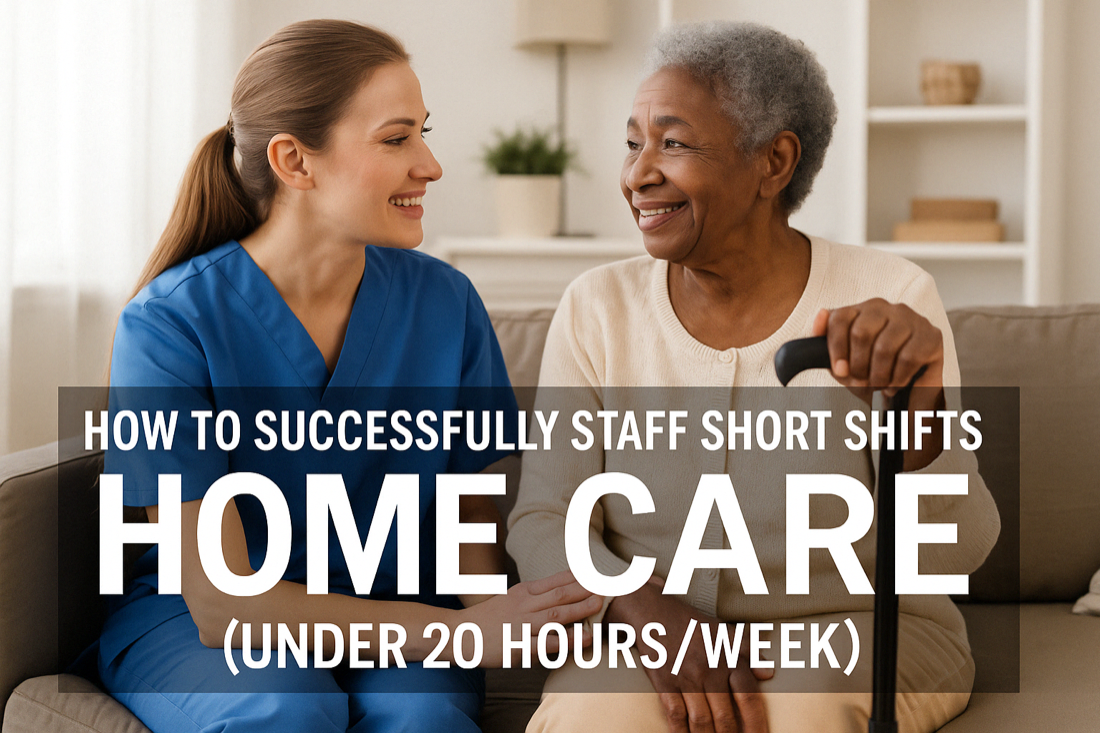
Struggling to staff short shifts under 20 hours per week in your home care agency? Discover proven strategies to reliably fill part-time caregiver shifts and improve retention.
Staffing short shifts in home care, especially those under 20 hours a week, remains one of the biggest operational headaches for agency owners and schedulers. These shifts are hard to fill. Many caregivers simply don’t want them. And even if someone says yes, there’s no guarantee they’ll follow through.
What often starts as a good hire can quickly turn into burnout, caregiver no-shows, or unnecessary turnover. Why? Because working a two-hour visit across town with no consistent schedule or meaningful incentives just doesn’t work for most caregivers.
This isn’t a “bad caregiver” problem. It’s a workforce systems problem. And solving it starts with acknowledging that short shifts are here to stay. Many clients don’t need full-time care. They just need help a few hours a day or a few times a week. The agencies that learn how to staff those shifts reliably are the ones that stay profitable, retain caregivers, and build lasting trust with families.
This article outlines practical, proven strategies for staffing part-time shifts, increasing caregiver engagement, caregiver retention, and strengthening your home care workforce management as a whole.

Before jumping to solutions, it’s important to understand the root causes of caregiver dissatisfaction with short shifts.
Common Issues:
Low pay for high effort: Driving across town for a 2-hour shift doesn’t always feel worth it, especially if gas prices are high or the client lives far away.
Lack of scheduling consistency: Caregivers often prefer full-time schedules for income stability.
Poor shift matching: Assigning short shifts without considering location, caregiver preferences, or skill sets leads to frustration.
No real incentive: Agencies ask caregivers to take short shifts, but don’t offer anything extra for the inconvenience.
Frequent cancellations or changes: Last-minute updates frustrate even your best staff.
To overcome these issues, agencies need to build smarter, more flexible, and reliable home care staffing systems that truly respect caregivers’ time and preferences.

Here are actionable ways your home care agency can successfully staff short shifts, retain caregivers, and improve client outcomes.
This is one of the most effective ways to make short shifts work. When caregivers can complete multiple short shifts in the same day and area, they’re more likely to commit long-term.
How to do it:
Use home care scheduling solutions that support geolocation or zip code mapping.
Assign caregivers to clients within a 5–10 mile radius.
Offer clustered shifts during interviews and onboarding.
Pro tip: Market these as “mini routes” during recruiting to appeal to gig economy workers used to delivery apps.
Not every caregiver wants or needs full-time hours. Some caregivers only want to work mornings. Others only weekends.
Build a part-time pool of caregivers made up of:
Retirees looking for supplemental income
College students with flexible afternoons
Stay-at-home parents free during school hours
How to recruit them:
Use job titles like “Weekend Companion Caregiver” or “Flexible Part-Time Caregiver”
Post to community centers, colleges, and job boards.
Offer 2-3 set shifts per week so they have consistency.
You’ll see higher satisfaction and fewer no-shows from caregivers who only want part-time caregiver shifts to begin with.
A small bonus can go a long way in motivating caregivers to accept and show up for short shifts. If a shift is under a certain number of hours (e.g., 3 or less), offer a bonus to make it more appealing.
Examples of effective caregiver incentives:
$10–$20 extra for completing a 2-hour shift.
$25 “streak bonus” for completing 5 short shifts in a week
A weekly drawing for gift cards for caregivers who accept and complete all their assigned shifts
These short shift bonus models improve reliability without adding huge expenses.
Having a small team of on-call caregivers who receive a premium rate to remain available for last-minute coverage makes it very easy.
On-call caregivers:
Can cover call-outs for short shifts.
Receive standby pay (e.g., $25/day) and higher hourly rates when called in.
Help you maintain client satisfaction with no interruptions in care.
They’re a key part of reliable home care workforce management, especially for agencies dealing with unpredictable client needs.
Many agencies lose great caregivers in the first few weeks simply because expectations weren’t clear. So, set the tone from the beginning. During the hiring and onboarding process, make it clear that some shifts will be part-time or under 20 hours per week.
Include in onboarding:
Short shift commitment agreements.
A “flexibility rating” where caregivers can opt into certain days/times/zip codes.
Training on time management and logistics for short shifts.
Transparency helps reduce resentment, confusion, and caregiver no-shows.
Use software that doesn’t just track hours, but actually supports better match-making between clients and caregivers
Use scheduling tools that automatically:
Match caregivers by availability, location, and client preferences.
Auto-notify caregivers of open shifts via text or app notifications.
Track caregiver reliability and preferences over time.
Modern home care scheduling solutions save hours of administrative time and reduce caregiver burnout.
Sometimes it’s not the short shift itself, but how it fits (or doesn’t fit) into a caregiver’s week.
Examples of flexible pairing:
4-hour morning shift + 3-hour evening shift on different days.
Companion care + light housekeeping visits in a single day.
2-day per week consistent assignments.
Give caregivers options during the week to build their own schedules based on your needs.
Train caregivers to handle a wider range of tasks so they can accept more visits.
Cross-training examples:
Personal care + medication reminders.
Companion care + housekeeping.
Alzheimer’s care + safe transfers.
Broader skills = fewer limitations. That makes staffing short shifts in home care easier for you, and more fulfilling for them.
Caregivers are more likely to commit to part-time shifts if they feel connected to their clients.
How to improve matching:
Use interest-based questionnaires (e.g., hobbies, pets, music).
Match language, cultural background, or personality traits.
Offer caregivers a say in which clients they take on.
Positive reinforcement is powerful. Celebrate the caregivers who show up, do the work, and take the tough shifts without complaint.
Ways to recognize them:
Monthly “Short Shift Hero” awards.
Caregiver spotlight features in your agency newsletter or social media.
Priority access to desirable shifts or bonuses
People who feel valued show up more consistently.

Even the best strategies can fall flat if the basics are ignored. Here are a few common pitfalls that can make short shift staffing harder:
Waiting too long to assign shifts — fill them during initial scheduling whenever possible.
Assigning the same caregiver over and over without checking in on their satisfaction.
Ignoring feedback from caregivers about routes, timing, or preferences.
Not planning ahead for holidays or weekends, which can result in last-minute panic.
Avoiding these missteps will support every part of your home care workforce management system.
It’s easy to view short shifts as a hassle. But with the right systems, they can actually become a strength. They allow for more flexible care plans, open the door to new types of caregivers, and give your agency the versatility to grow.
Here’s what you gain by getting this right:
Higher caregiver retention
More consistent client care
Better operational efficiency
Stronger reputation in your market
By combining the strategies above, plus thoughtful use of home care scheduling solutions and meaningful caregiver incentives, you can build a more agile and responsive agency.
Solving the short shift challenge isn’t about doing more. It’s about doing the right things with intention.
Be proactive. Listen to your caregivers. Use your data. And always plan ahead. Every shift under 20 hours is a chance to show clients and caregivers alike that your agency knows how to deliver consistently.
That’s how you build trust.
That’s how you grow.
If you’re a home care agency owner struggling to consistently staff part-time or short shifts, we offer consulting and tools to help you streamline your operations, improve caregiver retention, and grow your business.
Contact us today to get started or learn about our hiring and onboarding software built specifically for home care.